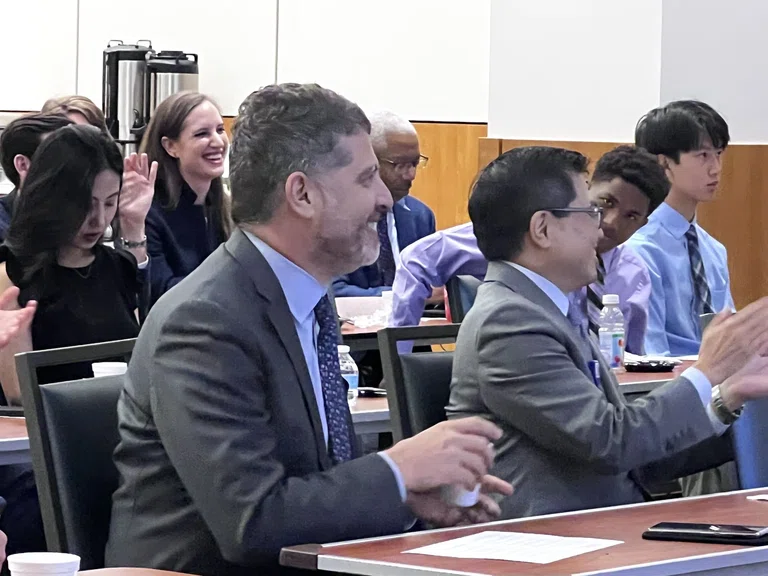

Archives
Visiting Professor Adheres to “Do No Harm” when Judging Innovation

Ronald B. Kuppersmith, MD, MBA, president of the American Board of Otolaryngology – Head and Neck Surgery (ABOHNS), recently told a filled auditorium of otolaryngologists, physicians and Texas Medical Center learners that he always falls back on the original ethical principles from medical school, including “do no harm,” when assessing surgery innovations. This can be challenging, he says, in the case of surgical innovation that has not yet been proven to be safe or effective, as surgery harms before it heals.
“Physicians have such a unique role in healthcare innovation. It’s a necessary balance. We want to make healthcare better for patients, but anything new needs to be tempered by keeping the patients’ ultimate health and interests in mind,” said Dr. Kuppersmith, visiting professor for the inaugural Dr. Sam Weber and Mrs. Simone Weber Lecture for the Department of Otolaryngology – Head & Neck Surgery Resident Research Day. His topic was “Perspectives on Surgical Innovation.”
“We have to separate practicing medicine from our personal aspirations and from wanting to be on the cutting edge,” said Dr. Kuppersmith, who has served as a founder, inventor, investigator, advisor and board member to help bring new technologies to otolaryngology – head and neck surgery. Currently, he is in private practice in College Station and is chief executive officer of ENT Specialty Partners. He also holds an appointment as Clinical Professor of Surgery at Texas A&M University College of Medicine. Besides serving on the board and as president of the ABOHNS, he also served as the youngest president of the American Academy of Otolaryngology-Head and Neck Surgery in 2009-2010 and has been president of the Texas Association of Otolaryngology Head and Neck Surgery.
“Medicine has become such a business today. But as physicians, we need to act with the professionalism and care for patients we learned in the first place,” he said.
In the first minutes of his lecture, Dr. Kuppersmith honored his friend and mentor Dr. Sam C. Weber, a well-known and much-loved Houston otolaryngologist who died at age 82 in 2022 after a lengthy illness that was complicated by COVID-19. His widow, Mrs. Simone Weber, attended the inaugural lecture and was acknowledged by the attendees for the family’s generosity in creating the research lectureship.
Dr. Kuppersmith reminded the audience of several historic devices that have been cast aside now because they lacked proven safety or efficacy in the patients. He said innovation requires incentives to be aligned including patient safety, clinical effectiveness/improved outcomes, operational efficiency and advancing knowledge. In some cases, innovations may be more costly and with limited access or envisioned to create profits at the expense of patient welfare. A surgical tool may be adopted too quickly without rigorous evaluation, and the protection of intellectual property can restrict advances in medicine.
He pointed out that FDA clearance “does not guarantee safety and/or efficacy,” and the ultimate burden will always be with the physician who must always focus on “the rights and well-being of patients.
Dr. Kuppersmith said he enjoyed his return to Houston where he spent his residency in Otolaryngology-Head and Neck Surgery at Baylor College of Medicine. He especially appreciates the multidisciplinary nature of healthcare within the square mile of the medical center. Since his training days, he said he has seen the city of Houston rally around the medical center and support the efforts being performed there, making it recognized around the world.
“Our specialty is very well represented, and the growth at Houston Methodist has been phenomenal,” he said. “Other places think about innovation and talk about innovation, but at the Texas Medical Center, they are doing innovation,” he added.
“And it’s more than medical devices (the subject of his recent talk), they are looking at innovative ways for healthcare in general, how to organize services, do research, add technology, just everything that will make medicine better.”
Everyone – competitors and colleagues – are physically connected and that “connectivity makes it even more interesting.”
In other words, he said with a smile, for healthcare professionals “the Texas Medical Center is the Disney World of Medicine.”






